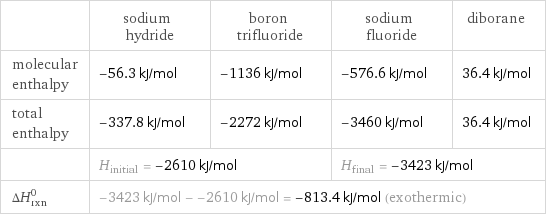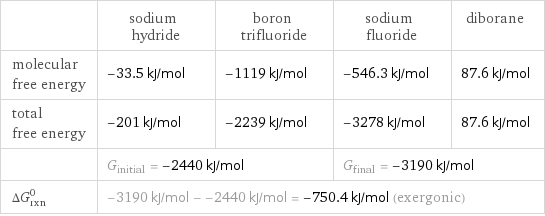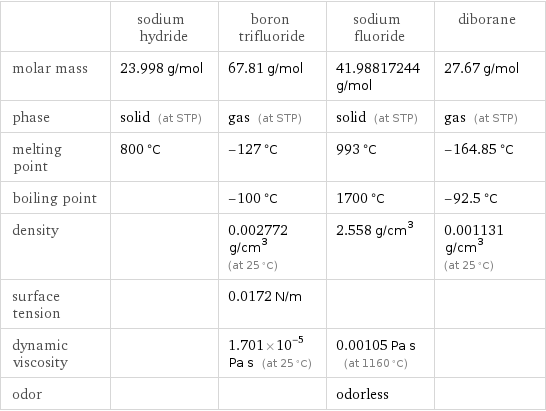Input interpretation

NaH sodium hydride + BF_3 boron trifluoride ⟶ NaF sodium fluoride + B_2H_6 diborane
Balanced equation

Balance the chemical equation algebraically: NaH + BF_3 ⟶ NaF + B_2H_6 Add stoichiometric coefficients, c_i, to the reactants and products: c_1 NaH + c_2 BF_3 ⟶ c_3 NaF + c_4 B_2H_6 Set the number of atoms in the reactants equal to the number of atoms in the products for H, Na, B and F: H: | c_1 = 6 c_4 Na: | c_1 = c_3 B: | c_2 = 2 c_4 F: | 3 c_2 = c_3 Since the coefficients are relative quantities and underdetermined, choose a coefficient to set arbitrarily. To keep the coefficients small, the arbitrary value is ordinarily one. For instance, set c_4 = 1 and solve the system of equations for the remaining coefficients: c_1 = 6 c_2 = 2 c_3 = 6 c_4 = 1 Substitute the coefficients into the chemical reaction to obtain the balanced equation: Answer: | | 6 NaH + 2 BF_3 ⟶ 6 NaF + B_2H_6
Structures

+ ⟶ +
Names

sodium hydride + boron trifluoride ⟶ sodium fluoride + diborane
Reaction thermodynamics
Enthalpy

| sodium hydride | boron trifluoride | sodium fluoride | diborane molecular enthalpy | -56.3 kJ/mol | -1136 kJ/mol | -576.6 kJ/mol | 36.4 kJ/mol total enthalpy | -337.8 kJ/mol | -2272 kJ/mol | -3460 kJ/mol | 36.4 kJ/mol | H_initial = -2610 kJ/mol | | H_final = -3423 kJ/mol | ΔH_rxn^0 | -3423 kJ/mol - -2610 kJ/mol = -813.4 kJ/mol (exothermic) | | |
Gibbs free energy

| sodium hydride | boron trifluoride | sodium fluoride | diborane molecular free energy | -33.5 kJ/mol | -1119 kJ/mol | -546.3 kJ/mol | 87.6 kJ/mol total free energy | -201 kJ/mol | -2239 kJ/mol | -3278 kJ/mol | 87.6 kJ/mol | G_initial = -2440 kJ/mol | | G_final = -3190 kJ/mol | ΔG_rxn^0 | -3190 kJ/mol - -2440 kJ/mol = -750.4 kJ/mol (exergonic) | | |
Equilibrium constant
![Construct the equilibrium constant, K, expression for: NaH + BF_3 ⟶ NaF + B_2H_6 Plan: • Balance the chemical equation. • Determine the stoichiometric numbers. • Assemble the activity expression for each chemical species. • Use the activity expressions to build the equilibrium constant expression. Write the balanced chemical equation: 6 NaH + 2 BF_3 ⟶ 6 NaF + B_2H_6 Assign stoichiometric numbers, ν_i, using the stoichiometric coefficients, c_i, from the balanced chemical equation in the following manner: ν_i = -c_i for reactants and ν_i = c_i for products: chemical species | c_i | ν_i NaH | 6 | -6 BF_3 | 2 | -2 NaF | 6 | 6 B_2H_6 | 1 | 1 Assemble the activity expressions accounting for the state of matter and ν_i: chemical species | c_i | ν_i | activity expression NaH | 6 | -6 | ([NaH])^(-6) BF_3 | 2 | -2 | ([BF3])^(-2) NaF | 6 | 6 | ([NaF])^6 B_2H_6 | 1 | 1 | [B2H6] The equilibrium constant symbol in the concentration basis is: K_c Mulitply the activity expressions to arrive at the K_c expression: Answer: | | K_c = ([NaH])^(-6) ([BF3])^(-2) ([NaF])^6 [B2H6] = (([NaF])^6 [B2H6])/(([NaH])^6 ([BF3])^2)](../image_source/b11b3178e7465cf88afdcfd08083f080.png)
Construct the equilibrium constant, K, expression for: NaH + BF_3 ⟶ NaF + B_2H_6 Plan: • Balance the chemical equation. • Determine the stoichiometric numbers. • Assemble the activity expression for each chemical species. • Use the activity expressions to build the equilibrium constant expression. Write the balanced chemical equation: 6 NaH + 2 BF_3 ⟶ 6 NaF + B_2H_6 Assign stoichiometric numbers, ν_i, using the stoichiometric coefficients, c_i, from the balanced chemical equation in the following manner: ν_i = -c_i for reactants and ν_i = c_i for products: chemical species | c_i | ν_i NaH | 6 | -6 BF_3 | 2 | -2 NaF | 6 | 6 B_2H_6 | 1 | 1 Assemble the activity expressions accounting for the state of matter and ν_i: chemical species | c_i | ν_i | activity expression NaH | 6 | -6 | ([NaH])^(-6) BF_3 | 2 | -2 | ([BF3])^(-2) NaF | 6 | 6 | ([NaF])^6 B_2H_6 | 1 | 1 | [B2H6] The equilibrium constant symbol in the concentration basis is: K_c Mulitply the activity expressions to arrive at the K_c expression: Answer: | | K_c = ([NaH])^(-6) ([BF3])^(-2) ([NaF])^6 [B2H6] = (([NaF])^6 [B2H6])/(([NaH])^6 ([BF3])^2)
Rate of reaction
![Construct the rate of reaction expression for: NaH + BF_3 ⟶ NaF + B_2H_6 Plan: • Balance the chemical equation. • Determine the stoichiometric numbers. • Assemble the rate term for each chemical species. • Write the rate of reaction expression. Write the balanced chemical equation: 6 NaH + 2 BF_3 ⟶ 6 NaF + B_2H_6 Assign stoichiometric numbers, ν_i, using the stoichiometric coefficients, c_i, from the balanced chemical equation in the following manner: ν_i = -c_i for reactants and ν_i = c_i for products: chemical species | c_i | ν_i NaH | 6 | -6 BF_3 | 2 | -2 NaF | 6 | 6 B_2H_6 | 1 | 1 The rate term for each chemical species, B_i, is 1/ν_i(Δ[B_i])/(Δt) where [B_i] is the amount concentration and t is time: chemical species | c_i | ν_i | rate term NaH | 6 | -6 | -1/6 (Δ[NaH])/(Δt) BF_3 | 2 | -2 | -1/2 (Δ[BF3])/(Δt) NaF | 6 | 6 | 1/6 (Δ[NaF])/(Δt) B_2H_6 | 1 | 1 | (Δ[B2H6])/(Δt) (for infinitesimal rate of change, replace Δ with d) Set the rate terms equal to each other to arrive at the rate expression: Answer: | | rate = -1/6 (Δ[NaH])/(Δt) = -1/2 (Δ[BF3])/(Δt) = 1/6 (Δ[NaF])/(Δt) = (Δ[B2H6])/(Δt) (assuming constant volume and no accumulation of intermediates or side products)](../image_source/77068a0817b39ec1a9f36fcc5be4ff7f.png)
Construct the rate of reaction expression for: NaH + BF_3 ⟶ NaF + B_2H_6 Plan: • Balance the chemical equation. • Determine the stoichiometric numbers. • Assemble the rate term for each chemical species. • Write the rate of reaction expression. Write the balanced chemical equation: 6 NaH + 2 BF_3 ⟶ 6 NaF + B_2H_6 Assign stoichiometric numbers, ν_i, using the stoichiometric coefficients, c_i, from the balanced chemical equation in the following manner: ν_i = -c_i for reactants and ν_i = c_i for products: chemical species | c_i | ν_i NaH | 6 | -6 BF_3 | 2 | -2 NaF | 6 | 6 B_2H_6 | 1 | 1 The rate term for each chemical species, B_i, is 1/ν_i(Δ[B_i])/(Δt) where [B_i] is the amount concentration and t is time: chemical species | c_i | ν_i | rate term NaH | 6 | -6 | -1/6 (Δ[NaH])/(Δt) BF_3 | 2 | -2 | -1/2 (Δ[BF3])/(Δt) NaF | 6 | 6 | 1/6 (Δ[NaF])/(Δt) B_2H_6 | 1 | 1 | (Δ[B2H6])/(Δt) (for infinitesimal rate of change, replace Δ with d) Set the rate terms equal to each other to arrive at the rate expression: Answer: | | rate = -1/6 (Δ[NaH])/(Δt) = -1/2 (Δ[BF3])/(Δt) = 1/6 (Δ[NaF])/(Δt) = (Δ[B2H6])/(Δt) (assuming constant volume and no accumulation of intermediates or side products)
Chemical names and formulas

| sodium hydride | boron trifluoride | sodium fluoride | diborane formula | NaH | BF_3 | NaF | B_2H_6 Hill formula | HNa | BF_3 | FNa | B_2H_6 name | sodium hydride | boron trifluoride | sodium fluoride | diborane IUPAC name | sodium hydride | trifluoroborane | sodium fluoride | diborane
Substance properties

| sodium hydride | boron trifluoride | sodium fluoride | diborane molar mass | 23.998 g/mol | 67.81 g/mol | 41.98817244 g/mol | 27.67 g/mol phase | solid (at STP) | gas (at STP) | solid (at STP) | gas (at STP) melting point | 800 °C | -127 °C | 993 °C | -164.85 °C boiling point | | -100 °C | 1700 °C | -92.5 °C density | | 0.002772 g/cm^3 (at 25 °C) | 2.558 g/cm^3 | 0.001131 g/cm^3 (at 25 °C) surface tension | | 0.0172 N/m | | dynamic viscosity | | 1.701×10^-5 Pa s (at 25 °C) | 0.00105 Pa s (at 1160 °C) | odor | | | odorless |
Units
